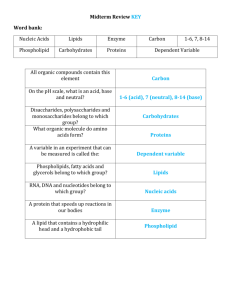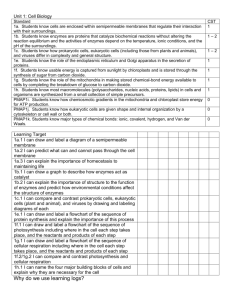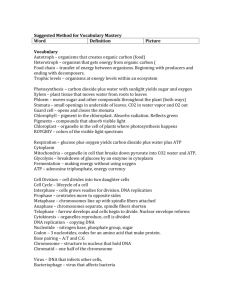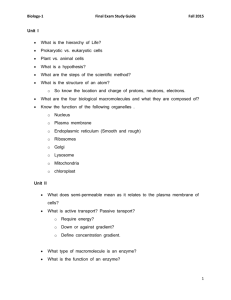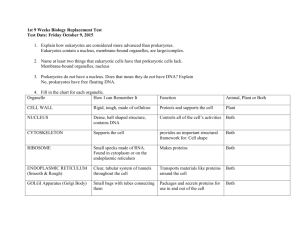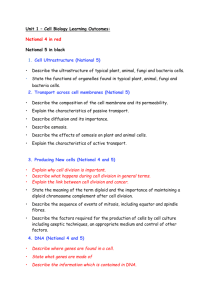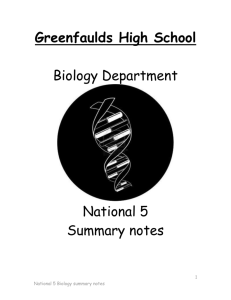National 5 Biology
advertisement
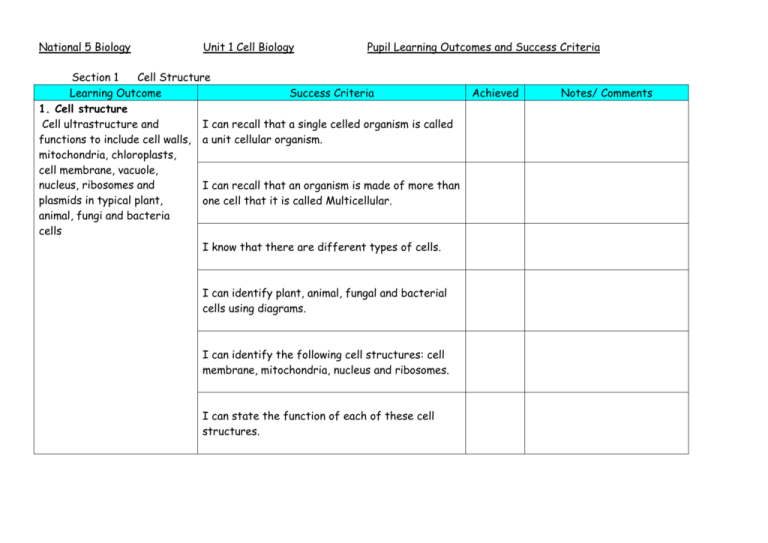
National 5 Biology Unit 1 Cell Biology Pupil Learning Outcomes and Success Criteria Section 1 Cell Structure Learning Outcome Success Criteria 1. Cell structure Cell ultrastructure and I can recall that a single celled organism is called functions to include cell walls, a unit cellular organism. mitochondria, chloroplasts, cell membrane, vacuole, nucleus, ribosomes and I can recall that an organism is made of more than plasmids in typical plant, one cell that it is called Multicellular. animal, fungi and bacteria cells I know that there are different types of cells. I can identify plant, animal, fungal and bacterial cells using diagrams. I can identify the following cell structures: cell membrane, mitochondria, nucleus and ribosomes. I can state the function of each of these cell structures. Achieved Notes/ Comments Learning Outcome Success Criteria I can identify the following cell structures: cell wall, chloroplasts and vacuole, I can state the function of each of these cell structures. I can state that bacteria have structures like plasmids and flagellum. I understand what theses structures are for. I know that yeast cells are plant cells that do not have chloroplasts. I know that yeast cells have budding scars, made during cell division. I can use a microscope successfully. Achieved Notes/ Comments Learning Outcome Success Criteria I understand what ‘total magnification’ means and how to calculate it. I can calculate the size of cells on slides. Achieved Notes/ Comments Section 2 Transport Across Cell Membranes Learning Outcome Success Criteria 2 Transport across cell membranes I can accurately describe the structure of the plasma membrane. a. The cell membrane consists of lipids and proteins and is selectively permeable. I can draw a simple diagram of a plasma membrane. I can describe the phospholipid bilayer and use the term ‘fluid mosaic model’ confidently. I can state the functions of the proteins found within a cell membrane. b. Passive transport is with the concentration gradient and does not require energy. c. The importance of diffusion in cells as the movement of molecules along a concentration gradient. I can explain the difference between passive and active transport. I can describe and explain the term ‘concentration gradient’. I can identify areas of high and low concentration. Achieved Notes/ Comments Learning Outcome Success Criteria I can describe and explain diffusion. d. Osmosis as the movement of water molecules across a membrane in terms of water concentration I can name some molecules that cross the plasma membrane by diffusion. I can describe and explain osmosis. I can identify areas of high and low water concentration. e. Animal cells can burst or shrink and plant cells can become turgid or plasmolysed in different solutions. I can use the terms Hypotonic, Hypertonic and Isotonic with confidence. I can explain the results of osmosis in animal cells I can explain the results of osmosis in plant cells. f. Active transport requires energy for membrane proteins to move molecules I can describe the terms Plasmolysed, Flaccid and Turgid and use them confidently. I can explain the term active transport. Achieved Notes/ Comments Learning Outcome against the concentration gradient. Success Criteria I can explain that this process requires energy. I can give an example of active transport. Achieved Notes/ Comments Section 3 Producing New Cells Learning Outcome Success Criteria 3 Producing new cells a. Maintenance of diploid I can state that the chromosome complement is chromosome complement by the total number of chromosomes present in an mitosis. organisms genome. Sequence of events of mitosis, including equator and spindle fibres. b. Cell production by cell culture requires aseptic techniques, an appropriate medium and the control of other factors. I can state that a cell with the full number of chromosomes is said to be diploid. I can state that gametes (sex cells) only contain half the chromosome complement and they are called haploid. I can state that humans have a chromosome complement of 46 chromosomes. I can state that this chromosome complement is maintained during cell division by the process of mitosis. I can give reasons as to why maintaining chromosome complement is important. Achieved Notes/ Comments Learning Outcome Success Criteria I can describe the stages of mitosis. I can identify chromosomes, chromatids, centromeres, centrioles and spindle fibres. I can describe the different stages of mitosis and identify them in diagrams. I can explain the purpose of mitosis. I can explain what aseptic technique is. I can perform procedures in aseptic technique. I can describe and explain the production of cells using aseptic technique. I can describe that cells need growth media to be cultured. Achieved Notes/ Comments Learning Outcome Success Criteria I can describe what factors need to be controlled during cell culture I can describe how fermenters are used in industry. Achieved Notes/ Comments Section 4 DNA, Production Of Proteins Learning Outcome Success Criteria 4 DNA and the production of proteins I can describe the structure of a DNA molecule. a. Structure of DNA: double stranded helix held by complementary base pairs. I can explain the term ‘complementary base pairs’. DNA carries the genetic information for making proteins. The four bases I can name the base pairs in DNA. A,T,C and G make up the genetic code. The base sequence determines amino I can draw and understand diagrams of the DNA acid sequence in protein. double helix. I can state that the strand of DNA is divided into packets of information called genes. I can explain that the sequence of bases on DNA is read in groups of 3 called (triplets) called codons. I can state that the sequence of the bases determines the sequence of amino acids that are joined together. Achieved Notes/ Comments Learning Outcome Success Criteria I can state that the sequence of amino acids determines protein structure and shape and this determines function. b. Messenger RNA (mRNA) is a molecule which carries a copy of the code from the DNA, in the nucleus, to a ribosome, where the protein is assembled from amino acids I can state that the DNA bases do not leave the nucleus. I can describe the journey of the instructions to make a protein from the base sequence on the DNA to the final protein. Achieved Notes/ Comments Section 5 Proteins and Enzymes Learning Outcome Success Criteria 5. Proteins and enzymes a. The variety of protein I can state that the sequence of amino acids in a shapes and functions arises protein determines the shape of a protein. from the sequence of amino acids. I can explain that the bonds between the amino acids cause the shape of the protein to be formed and that it is the same every time the protein is made. I can state that the shape of a protein determines the function of the protein. b. Functions of proteins to include structural, enzymes, hormones, antibodies. I can describe the function of structural proteins I can describe the function of enzymes. I can describe the function of hormones. I can describe the function of antibodies. I can describe a conjugated protein. Achieved Notes/ Comments Learning Outcome c. Enzymes function as biological catalysts and are made by all living cells. They speed up cellular reactions and are unchanged in the process. The shape of the active site of an enzyme molecule is complementary to a specific substrate. d. Each enzyme works best in its optimum conditions. Enzymes and other proteins can be affected by temperature and pH, which result in changes in their shape. A change in shape will affect the rate of reaction and may result in denaturation. Success Criteria I can describe and explain the effects of temperature on proteins, using enzymes as a named example. I can describe and explain the effects of ph on proteins, using enzymes as a named example. I can explain what the term ‘Optimum’ means and apply it to temperature and pH effects on enzymes. Achieved Notes/ Comments Section 6 Genetic Engineering Learning Outcome Success Criteria 6 Genetic engineering Genetic information can be I can give a definition of genetic engineering. transferred from one cell to another naturally of by genetic engineering. Stages I can describe the stages of genetic engineering. of genetic engineering to include: identify section of DNA that contains required I can identify the processes involved in genetic gene from source engineering from diagrams. chromosome, extract required gene, insert required I can identify the plasmid in a bacterial cell gene into vector/bacterial diagram. plasmid, insert plasmid into host cell and grow transformed cells to produce I can give examples of the benefits of genetic a GM organism. engineering. I can give reasoned arguments both in support of and against genetic engineering. I can understand the issues, concerns and benefits of GM foods. Achieved Notes/ Comments Section 7 Photosynthesis Learning Outcome Success Criteria 7 Photosynthesis a. Chemistry of I can state that photosynthesis is the process by photosynthesis, as a series of which organic compounds are made by the enzyme controlled reactions, reduction of carbon dioxide. in a two stage process. Light reactions: the light energy from the sun is I can state that the raw materials for trapped by chlorophyll in the photosynthesis are: water, carbon dioxide and chloroplasts and is converted energy from the sun. into chemical energy in the form of ATP. Water is split to produce hydrogen and I can state the chemical formulae for carbon oxygen. Excess oxygen dioxide, water, glucose and oxygen. diffuses from the cell. Carbon fixation: hydrogen and ATP produced by the light I can write a balanced chemical equation for reaction is used with carbon photosynthesis. dioxide to produce sugar. b. The chemical energy in sugar is available for I can state that photosynthesis is split into two respiration or can be enzyme controlled stages: Photolysis and Carbon converted into plant products Fixation. such as starch and cellulose. I can accurately describe the stages of photolysis. Achieved Notes/ Comments Learning Outcome Success Criteria I can state that ATP is a special molecule that can transfer energy from one reaction to another. I can state that Oxygen is a by-product of this reaction and that it is released into the atmosphere. I can accurately describe the stages of Carbon Fixation. I can describe the fate of the sugar produced during photosynthesis. c. Limiting factors: carbon dioxide concentration, light intensity and temperature and their impact on photosynthesis and cell growth. I can explain the term Limiting Factors. I can list limiting factors for photosynthesis. I can explain a limiting factor graph. Achieved Notes/ Comments Section 8 Respiration Learning Outcome Success Criteria 8 Respiration a. The chemical energy stored I can describe the chemical ATP. in glucose must be released by all cells through a series of enzyme controlled I can understand the use of ATP in energy reactions called respiration transfer. b. The energy released from the breakdown of glucose is used to generate ATP from ADP and phosphate. The chemical energy stored in ATP can be released by breaking it down to ADP and phosphate. This energy can be used for cellular activities including muscle cell contraction, cell division, protein synthesis and transmission of nerve impulses. ATP can be regenerated during respiration. I can state that respiration is a chemical reaction using oxygen to release energy. I can state that respiration is a series of enzyme controlled reactions. I can state that when oxygen is not present energy is still released using alternative pathways. I can state that these alternative pathways are known as anaerobic respiration. Achieved Notes/ Comments Learning Outcome The breakdown of each glucose molecule via pyruvate to carbon dioxide and water in the presence of oxygen yields 38 moleucles of ATP. The breakdown of each glucose molecule via the fermentation pathway yields 2 molecules of ATP when oxygen is not present. Breakdown of glucose to lactic acid via pyruvate in animal cells. Breakdown of glucose to alcohol/ethanol and carbon dioxide via pyruvate in plant and yeast cells. c. Aerobic respiration starts in the cytoplasm and is completed in the mitochondria. Fermentation occurs in the cytoplasm. Success Criteria I can describe the alternative pathways in animal cells and plant cells. Achieved Notes/ Comments
